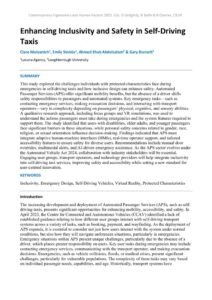| Document | Author Clare Mutzenich, Emily Stobbs, Ahmed Ehab Abdelsalam & Gary Burnett |
| Abstract This study explored the challenges individuals with protected characteristics face during emergencies in self-driving taxis and how inclusive design can enhance safety. Automated Passenger Services (APS) offer significant mobility benefits, but the absence of a driver shifts safety responsibilities to passengers and automated systems. Key emergency tasks—such as contacting emergency services, making evacuation decisions, and interacting with transport operators—vary in complexity depending on passengers’ physical, cognitive, and sensory abilities. A qualitative research approach, including focus groups and VR simulations, was used to understand the actions passengers must take during emergencies and the system features required to support them. The study identified that users with disabilities, older adults, and younger passengers face significant barriers in these situations, while personal safety concerns related to gender, race, religion, or sexual orientation influence decision-making. Findings indicated that APS must integrate adaptive human-machine interfaces (HMIs), real-time operator support, and tailored accessibility features to ensure safety for diverse users. Recommendations include manual door overrides, multimodal alerts, and AI-driven emergency assistance. As the APS sector evolves under the Automated Vehicle Act 2024, collaboration with industry stakeholders will be essential. Engaging user groups, transport operators, and technology providers will help integrate inclusivity into self-driving taxi services, improving safety and accessibility while setting a new standard for user-centred innovation. |

